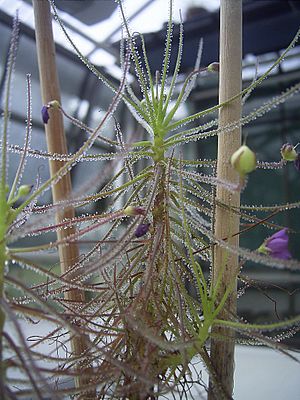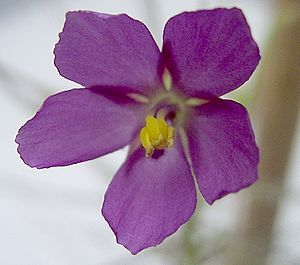Byblis aquatica facts for kids
Quick facts for kids Byblis aquatica |
|
|---|---|
 |
|
| Conservation status | |
| Scientific classification | |
| Genus: |
Byblis (plant)
|
| Species: |
aquatica
|
Byblis aquatica is an insectivorous plant belonging to the genus Byblis, commonly known as the rainbow plants. It was described by Allen Lowrie and John Godfrey Conran in 1998, assigned to a group of annual north Australian species known as the "Byblis liniflora complex". It grows in semi-aquatic conditions and uses stalked mucilaginous glands (similar to those employed by the unrelated sundews and Drosophyllum) covering its leaf surfaces to attract, catch, and digest insect prey to supplement the poor environmental nutrient supply.
Plant characteristics
Habit
Byblis aquatica is an annual plant with a usually unbranching central stem supported by fine, fibrous roots. The central stem can reach a length of 45 centimetres (18 in), although it is only able to support its own weight during early growth (<5 cm.). After that it leans on neighboring plants for support, eventually toppling and growing horizontally along the ground or water surface, with only the growth tip growing uprightly.
Leaves
The plant's leaves are 2–4 centimetres (0.79–1.57 in) long, highly filiform (elongated and narrow), round in cross-section and tapering at the end. Young leaves are bright green and grow uprightly; as they age, they darken to a maroon (color) and droop. The leaf surface is covered with stalked mucilaginous glands along its entire length. These serve not only to attract and trap insect prey, but also allow the plant to "hold on" to neighboring structures for support.
Flowers and fruit
Byblis aqauatica flowers are born singly at the tip of 1.5–3-centimetre (0.59–1.18 in) stems similar in appearance to the leaves. These emerge from the leaf axes in mature plants. The five-petaled flowers deep purple flowers appear between January and May (during the Australian summer), although only a few at a time.
The generally glabrous, ovate sepals are 3–4 millimetres (0.12–0.16 in) long. The obovate petals are deep purple, 5–7 millimetres (0.20–0.28 in) long and up to 4.5 millimetres (0.18 in) wide, and have notched margins. The filaments are 2–2.5 millimetres (0.079–0.098 in) long, bearing 0.9–1.3-millimetre (0.035–0.051 in) anthers. The pistils are 2–2.5 mm long and bear a rough stigma.
Fertilized flowers mature to form a 3–4-millimetre (0.12–0.16 in) by 2.5–4-millimetre (0.098–0.157 in) egg-shaped, two-parted seed capsules. As the seed capsule dries out it cracks open (dehisces), dropping the seed on the ground or water surface (see the gravity and water dispersal). The black, 1–1.3-millimetre (0.039–0.051 in) long seeds are grooved lengthwise.
Distribution
This species has a very limited distribution in the Australian Northern Territory. It is endemic to the area between Darwin and Berry Springs, but is fairly common there. It grows in the loamy sand of seasonally flooded depressions and in the shallow margins of freshwater lagoons. Here it shares its habitat with B. liniflora. which is however native to dryer regions elsewhere.
Botanical history
Byblis aquatica was first collected by Allen Lowrie in April 1988. In cultivation it was taken for an ecotype of B. liniflora and assigned the name Byblis aff. liniflora "Darwin". It remained thus until Barry Meyers-Rice demonstrated evidence of the reproductive isolation of the species, at which Jan Flisek suggested the description of the taxa as a new species in 1996. Allen Lowrie did so as part of his revision of north Australian species in 1998.
- Lowrie, Allen and Conran, John G. 1998. A Taxonomic Revision Of The Genus Byblis (Byblidaceae) In Northern Australia. In: Nuytsia 12(1):59-74.
- Conran, John G. and Lowrie, Allen. 1993. Byblis liniflora subsp. occidentalis (Byblidaceae), A New Subspecies From North-Western Australia. In: Austral. Syst. Bot. 6: 175-179.
- Meyers-Rice, Barry. Byblis - Notes On Forms New To Cultivation. In: Carnivorous Plant Newsletter 22: 39-40.
- Flísek, Jan. Byblis aff. liniflora "Darwin" - Novy druh rodu Byblis? In: Trifid, Darwiniana 4: 27-28, 43.




